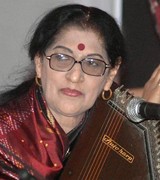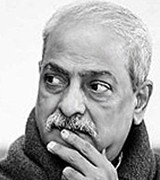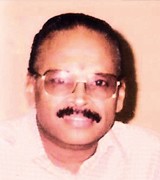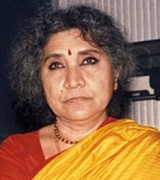COVER STORY
KISHORI AMONKAR (1931-2017) - Queen of romanticism
Deepak S. Raja

Kishori Amonkar has by far been the most influential female Hindustani vocalist to emerge in independent India. Daughter and disciple of Jaipur-Atrauli gharana stalwart Mogubai Kurdikar, she acquired her stature from her originality as an interpreter of the gharana’s musical wisdom. She jettisoned the classicism of her gharana’s style in favour of a marked romanticism, braved criticism from conservative opinion and triumphed. As a result, her revisionist style has now come to signify Jaipur-Atrauli vocalism, while its orthodox stream has drifted towards history.
Kishori was not only a formidable musician, but also the chief ideologue of the romanticist movement—by the power of her intellect, erudition, and excellent articulation in at least three languages, including English. She was, incidentally, known to possess one of the finest private libraries on musicology and aesthetics. She held audiences spellbound at seminars and conferences, as much as she did on the concert platform.
THEATRE
MAHESH ELKUNCHWAR - A guru of Marathi theatre
V. Ramnarayan

From being a monthly devoted to classical music and dance to grow into one with a wider coverage including theatre is a step that we have taken slowly, cautiously. In this quiet expansion, we have been largely helped by the multifaceted writer-intellectual Indira Parthasarathi, whose bimonthly column deals with drama through the ages.
When Mahesh Elkunchwar, one of the most distinguished playwrights of modern India, agreed to curate and present a series of articles—originally written for Smita Smriti, an annual publication in memory of the iconic actress Smita Patil—by some leading women contributors to Indian theatre including playwrights and theatre directors, we saw an opportunity to provide our readers window into the history of contemporary theatre in India.
Elkunchwar gave twenty questions to each of these contributors, who each replied to him in her own way. What emerged has been a veritable tour-de-force of the stage as practised and performed in the country by some of its brilliant exponents in the last five or six decades. We deem it our privilege that Elkunchwar and the 15 theatrepersons of his choice agreed to the serialisation of their insightful writings in Sruti.
MUSICIANS OF KERALA
NEYYATTINKARA M.K. MOHANACHANDRAN
C. Ramakrishnan

Neyyattinkara is a municipal town on the banks of the Neyyar river 20 kilometres south of Thiruvananthapuram. This serene place flush with paddy fields, coconut, tapioca, banana and arecanut gardens gave birth to two of the state’s towering Carnatic musicians—Vasudevan and Mohanachandran who were also contemporaries. Mohanachandran was born on 11 October 1939 and had his initial training from his mother Anandavalli Amma, an accomplished musician serving as a deputy secretary with the government of Kerala. He later learnt from local musicians before enrolling for B.A. (Music) at Annamalai University and Master of Music at the University of Mysore. At Annamalai University he was privileged to study under great stalwarts like M.M. Dandapani Desigar, T.K. Rangachari, and Dr. S. Ramanathan. In the University of Mysore, Prof. M. Visweswaran and Dr. Gowri Kuppuswamy, noted musicologist, were his mentors. He gained teaching experience in various colleges of the University of Kerala such as Government College for Women, Trivandrum, Government Music College, Chittoor and Palghat. He was Head of the Music Department, Faculty of Fine Arts, and Chairman, University of Kerala, the Board of Studies in Music, Sree Sankaracharya University, Kalady, Kerala. He also served Calicut University, Gandhiji University, Madurai Kamaraj University, and University of Mysore.
PROFILE
VINJAMURI ANASUYA DEVI - Many firsts to her credit
Gowri Ramnarayan

Vinjamuri Anasuya Devi. When I met her nearly a decade ago for an interview for The Hindu, she sang Anbe ellam taruven from film Vikatakavi in a voice that was resonant and riveting at 88. “This harmonium is older than I am,” she said. “These are called Mohana reeds. What sweetness!”
“I belong to a family of poets and artists. My ancestors were diwans and pundits at the Pithapuram court,” she told me with pride. Father Venkata Lakshminarasimha Rao, a Telugu-Sanskrit pundit, was a scholarly author and amateur stage actor. Mother launched and edited Anasuya, the first women’s magazine in Telugu, featuring women writers and Ajanta style illustrations. “The Maharani of Pithapuram sent recipes from the royal cuisine!” Anasuya was named after the magazine.
Influenced by the Brahmo Samaj movement and the freedom struggle, the elders of her family supported widow remarriage and inter-caste marriages—“though not within the family,” Anasuya Devi laughed. The women learnt Sanskrit, and studied literary texts from home tutors. They breathed Telugu poetry. Uncle Devulapalli Krishna Sastri was a major poet of Andhra.


